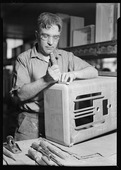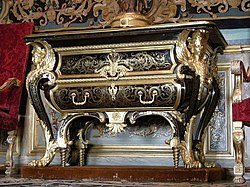Cabinet making
Cabinet making, also spelled cabinetmaking[1] or "cabinet-making" with a hyphen,[2] is the use of fine woodworking skills to make cabinets and furniture.
Cabinetmakers learn to use the tools of the cabinet making trade.[1]
History
There were few full-time furniture makers in England or America until the last half of the 17th century.[3]
In the 18th century, some European cabinetmakers became well known.[2] Cabinet making was an essential trade in early British North America. It was a huge money maker. They made furniture like cabinets, chairs, doors, drawers, cupboards, bed frames, tables, and many more. They used gimlets, gouges, bow saws, chisels, braces, and hacksaws to make their furniture. The wood they used was oak, maple, cypress, chestnut, and yellow pine.
Gallery
Cabinet Making Media
Cabinet; by Francesco Del Tuppo; c. 1606–1623; oak and poplar veneered with various exotic hardwoods, with ebony moldings and plaques of marble, and various other materials; 59.1 × 96.8 × 35.9 cm; Metropolitan Museum of Art (New York City)
Commode by André-Charles Boulle at Vaux-le-Vicomte
Tortoise-shell cabinet of Polish king John III Sobieski, looted by the Germans from the Wilanów Palace during World War II
Related pages
References
- ↑ 1.0 1.1 Seattle Central Community College, "Cabinetmaking" Archived 2012-11-14 at the Wayback Machine; retrieved 2012-11-26.
- ↑ 2.0 2.1 Melikian, Souren. "Cabinet-Making Team That Dazzled the Elite," New York Times. November 23, 2012; retrieved 2012-11-26.
- ↑ Colonial Williamsburg, "Cabinetmaker"; retrieved 2012-11-26.
Other websites
| Wikimedia Commons has media related to Lua error in Module:Commons_link at line 62: attempt to index field 'wikibase' (a nil value).. |
- Short History of Cabinets at FineWoodWorking.com Archived 2009-03-28 at the Wayback Machine






